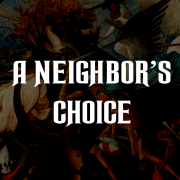Christ’s Delight—An Analysis of Babette’s Feast
Babette’s Feast is a fascinating 1987 Danish film, not just for its spiritual message but also for its anthropological implications. It was a favorite of Pope Francis’s and is recommended by the Vatican in its list of important films. My personal opinion agrees with that of Pope Francis; every Christian should watch this movie.
Despite the simplicity of the plot, this Oscar-winner conveys gigantic meaning through symbols and emotion. The story is set in a nineteenth-century village on the remote western coast of Jutland (parts of modern-day Denmark and Germany). The inhabitants of this village are exemplified by two pietistic sisters of exceptional beauty sought after by numerous suitors, some of whom are immediately rebuffed by the girls’ Pastor father. Life in the village is distinctly devout but also guarded. When one of the suitors—an opera singer—presents himself the father raises his eyebrows. “Are you a papist?” he asks. The smitten baritone eagerly nods of course.
Fast forward and we see that the Pastor has passed away and his daughters have grown old. Here, a new character is introduced; her name is Babette and she is a widowed Frenchwoman who has just fled her home country. After being recommended to the two sisters as a housekeeper, she starts working and gaining the respect of the locals. For fourteen years, Babette works loyally and without complaint. She is, however, shown grieving in times of loneliness. After all, she has lost everything, and the only link to her home country is a lottery ticket, which is renewed annually by a friend in Paris.
Babette is a peculiar character; she is the Christ archetype of this story. Her image is a mirror of the “Man of Sorrows.” Her arrival in this obscure little village is reminiscent of the Nativity story where the infant Christ was born as an outsider in Bethlehem. Babette is accepted only reluctantly by the two sisters in similar fashion to how Christ was accepted by only a few, and the Protestant inhabitants of this village almost remind us of 1st century Judea where people were rigorously dedicated to outward signs of faith, fearful of any type of innovation. These villagers soon descend into disputes that threaten the stability of the sisters’ congregation. All does not look well.
One day, Babette’s lottery ticket fetches her ten thousand francs. The two sisters congratulate her but they also realize that Babette would now be able to go home a rich woman. To their surprise, Babette invites the church members to a celebratory French dinner. Exotic ingredients for the meal start shipping in. Wine, figs, quail, champagne, turtle! The arrival of these unfamiliar foodstuffs spark worry and gossip among the modestly-fed villagers. Fearing the meal may become an indulgence or sin, the sisters and the congregation agree to eat without expressing any pleasure or discussing the food during dinner. “Oh, how often I think of my father now,” one of the sisters gasp, “I feel he’s looking down and watching his daughters use his home for a witches’ sabbath!”
Our modern sensibilities are irritated when we see puritanical Christians guarding themselves from bodily pleasures. But we are far too naive to realize that these Christians have every right to be cautious. When we deconstruct ancient myths and folklore we recognize that many feasts, often undifferentiated in nature, end with human sacrifice. Wine, for instance, often serves to intoxicate and instill stupor into a frenzied mob. Dionysus himself was said to have been cannibalized by intoxicated mobs. Christianity, of all religions, recognizes the hidden violence behind sensuality. In light of all this, the Christians were simply reasserting communal taboos, which are guardrails against mimetic crises.
Where the Christians go wrong is their inability to comprehend the implications of Christ’s incarnation. Sadly, this error is repeated even today when we prioritize the upholding of taboos over partaking in the Agape meal of Christ. In Luke’s Gospel, Jesus says, “Blessed are you who hunger now, for you will be satisfied.” Too often, we relegate the effect of Christ’s bodily resurrection to the afterlife when, in fact, many of Christ’s miracles, including the feeding of the multitude, happened during His earthly ministry. This should indicate that the Gospel is a complete reversal of mythic violence in ancient religions. Where there was once human sacrifice at the end of the feast, there is now creative self-sacrifice. Where there was once scarcity, there now lies abundance. In His feeding of the multitude, Jesus gives us the precedent by which we are to solve crises in our own societies. We Christians are to be like Babette and freely give away, not expecting anything in return.
Babette’s French dinner not only exceeds everyone’s expectations, but it also brings an end to the quarreling of the church members and sends them singing on their way home. After the feast, Babette tells the sisters that she had spent the entirety of the lottery money on the dinner. She had given everything away. The sisters gasp, “Now you’ll be poor for the rest of your life!” To this, Babette replies, “An artist is never poor.”
“But this is not the end, Babette. I feel for certain that this is not the end. In paradise you will be the great artist God meant you to be,” the sisters proclaim, “Ah, how you will enchant the angels!” Babette had poured her heart and soul into the meal yet she did not receive any applause. Not even was her presence revealed to the dinner attendees. This is one of the hardest parts of imitating Christ. Our fallen nature demands instant gratification, and we expect to be rewarded immediately. Are we willing to forego fame, adulation, or even basic necessity in the service of those in need? Iconographers never sign their names on their creation. The reason they don’t is because they are willing to sacrifice their individuality for the sake of God’s glory. This may seem extreme to those of us who grew up in cultures that reward excellence, but in God’s eyes, reward often means the welfare and prosperity of others. Therefore, Babette is right when she says that the artist is never poor, for the artist’s richness lies in preparing the world for Christ’s dwelling.












Leave a Reply
Want to join the discussion?Feel free to contribute!